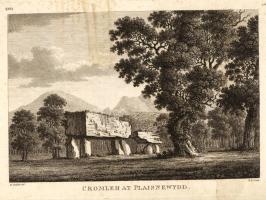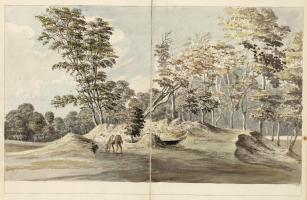Text this colour links to Pages. Text this colour links to Family Trees. Place the mouse over images to see a larger image. Click on paintings to see the painter's Biography Page. Mouse over links for a preview. Move the mouse off the painting or link to close the popup.
All About History Books
The Chronicle of Abbot Ralph of Coggeshall describes the reigns of Kings Henry II, Richard I, John and Henry III, providing a wealth of information about their lives and the events of the time. Ralph's work is detailed, comprehensive and objective. We have augmented Ralph's text with extracts from other contemporary chroniclers to enrich the reader's experience. Available at Amazon in eBook and Paperback.
A Tour of Wales by Thomas Pennant is in Georgian Books.
Georgian Books, A Tour of Wales by Thomas Pennant Volume 4

In the woods are some very remarkable druidical antiquities [Plas Newydd Burial Chamber [Map]. Behind the house [Plas Newydd] are to be feen two vast Cromlechs. The upper stone of one is twelve feet seven inches long, twelve broad, and four thick, supported by five tall stones. The other is but barely separated from the first: is almost a square, of five feet and a half, and supported by four stones. The number of supporters to Cromlechs are merely accidental, and depend on the size or form of the incumbent stone. These are the most magnificent we have, and the highest from the ground; for a middle-sized horse may easily pass under the largest.

Nor far from the Cromlech is a large Carnedd [Bryn yr Hen Bobl Burial Chamber [Map]]: part has been removed, and within was difcovered a cell about seven feet long and three wide, covered at top with two flat stones, and lined on the sides with others. To get in I crept over a flag, placed across the entrance. On the top of the stone were two semicircular holes, of size sufficient to take in the human neck; it is conjectured that above might have been another; so that both together might perform the office of a stocks. It is indeed conjecture, yet not an improbable one, that in this place had been kept the wretches destined for sacrifice; as it is well known that they performed those execrable rites, and often upon captives who had suffered long imprisonment, perhaps in cells similar to this.
Great Carnedd [Bryn yr Hen Bobl Burial Chamber [Map]], The name of this place is taken from an immense Carnedd, or heap of stones, surrounded with great upright stones, in an adjacent field. It seems to have beneath it passages formed on the sides and tops with flat stones, or flags. These were the repositories of the dead. Not that bones or urns are also discovered in them; for the founders, like those of the pyramids of Egypt, appear often to be disappointed in their hopes of having their reliques lodged in these labored Mausoleums.
A few years ago, beneath a carnedd similar to that at Tregarnedd, was discovered, on a farm called Bryn-celli-ddu [Bryn Celli Ddu Burial Mound [Map]], near the seat of Sir Nicholas Bayley [Plas Newydd House, Anglesey], a passage three feet wide, four feet two or three inches high, and about nineteen feet and a half long, which led into a room, about three feet in diameter, and seven in height. The form was an irregular hexagon, and the sides composed of six rude flabs, one of which measured in its diagonal eight feet nine inches. In the middle was an artless pillar of stone, four feet eight inches in circumference. This supports the roof, which consists of one great stone, near ten feet in diameter. Along the sides of the room was, if I may be allowed the expression, a stone bench, on which were found human bones, which fell to dust almost at a touch: it is prosbable that the bodies were originally placed on the bench. There are proofs that it was customary with the Gauls to place their dead in that form in cells; but they added to the head of each body a stone weapon, which served as a pillow: but nothing of the kind was discovered in this sepulchre. The diameter of the incumbent carnedd is from ninety to a hundred feet. This seems to be that which Mr. Rowland takes notice of in his Mona Antiqua.